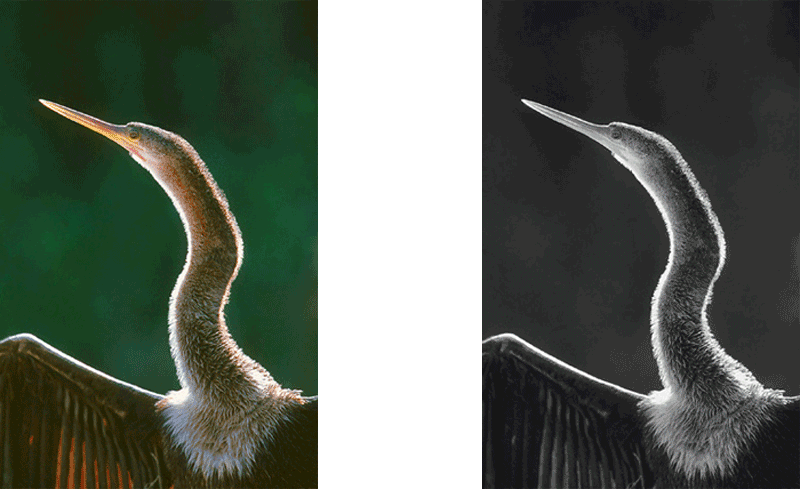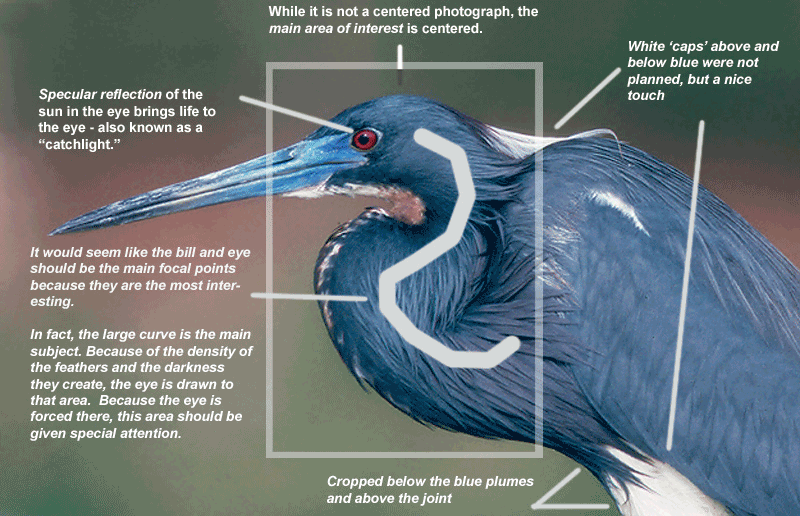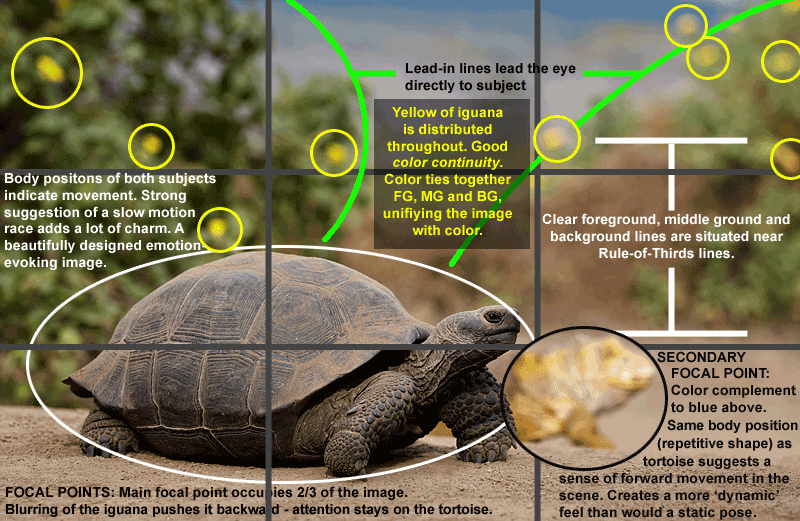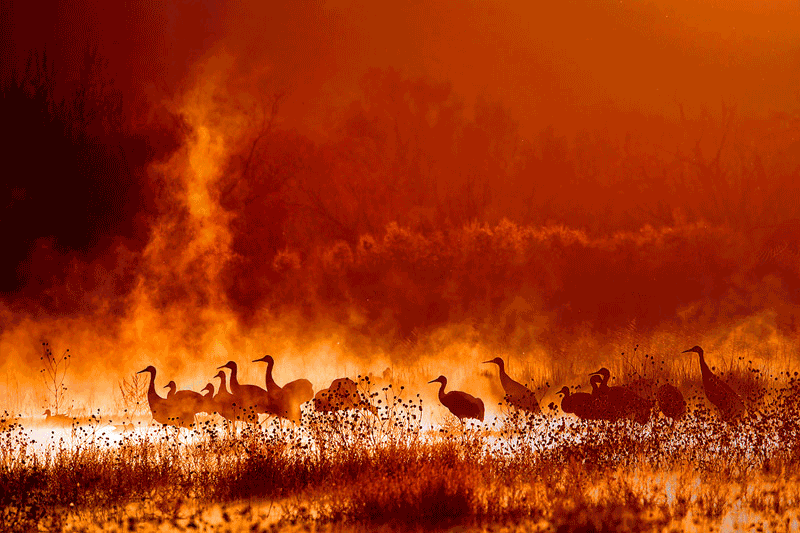| [Not a valid template] |
|
Natural Design is a beautiful and informative e-book written by award winning photographer and painter Gloria Hopkins. |
NATURAL DESIGN, an e-book by GLORIA HOPKINS
It must have been more than ten years ago, perhaps well more, when I first saw one of Gloria’s composition maps. I was intrigued by them and urged her to follow up on the idea. Well she did and now we are able to offer you a finely polished version of her killer e-book, Natural Design: Image Design for Nature Photographers. The great strengths of Natural Design lie in the writing, its comprehensive coverage of the subject matter, and those fabulous composition maps.
Once I realized that I needed to get the bird out of the center of the frame–heck, that was back in 1984–composition came rather easily and naturally to me. I know from teaching on IPTs and at seminars, however, that many folks struggle with the principles involved in designing a pleasing image. This book was written for those folks. Natural Design features in-depth coverage of color, perspective, balance, symmetry, shape and form, points and lines, light, visual paths, tones and textures, mood and emotion, evaluating art, framing, cropping, ethics, execution, impacts, pitfalls, mistakes, clutter, developing a personal style, and lots, lots more. If it has to do with designing a beautiful image, Gloria has it covered.
Of the composition maps, Gloria writes, Folks who understand composition intuitively love the maps because they give names and terms to what the photographer already knows. I can’t tell you how many times I’ve heard “I knew that; I just never knew how to explain it!” At the very least, they can speak a little more intelligently about their photography. And raw beginners like them because they’re visual and they make unfamiliar concepts easy to understand.
BIRDS AS ART is proud to announce the availability of the revised edition of Natural Design, yet another in the growing line of brilliant educational materials written by friends and shared with you. (You can learn of the others here.) And you can learn more about Gloria here. Be sure to check out her water colors in the Painting section of her site and the sheaf of photography articles and her image galleries in the Photography section.
Thanks a stack to Mike Hannnisian for helping me edit this extensive and comprehensive guide. A quick visit to Mike’s web site will reveal that he is a skilled and completely dedicated photographer and writer. Mike will be co-leading the 2012 Bosque IPT with me.
You can order your copy of “Natural Design” for only $30 right now by calling 863-692-0906 with your credit card in hand, by sending a PayPal to birdsasart@verizon.net or birdsasart@att.net, from the BAA On-line Store here, or by sending us a check made out to Arthur Morris for $30 to us here: Arthur Morris/BIRDS AS ART, PO Box 7245, Indian Lake Estates, FL 33855. Be sure to include your e-mail address and the words Natural Design on your check. You will receive download instructions via e-mail.
Featuring
- Chapter One: Design in Nature Photography
- Chapter Two: Nature Photography in American History
- Chapter Three: The Visual Experience
- Chapter Four: The Photographic Experience
- Chapter Five: Considerations for Purpose
- Chapter Six: The Physical Photograph
- Chapter Seven: Designing the Tangibles
- Chapter Eight: Designing the Intangibles
- Chapter Nine: Considerations for our Natural Subjects
- Chapter Ten: Popular Composition Styles
- Chapter Eleven: Composition Maps
I was so impressed with your e-book that I made it required reading for the students in my college photography course. It is one of the few books I have seen that focuses on composition which is always the weakest point for my beginning photography students. Bob Boner, Maryland
NATURAL DESIGN TABLE OF CONTENTS
PART ONE
Chapter One: Design in Nature Photography
The Visual Language 12
The Importance of Learning Design 13
Demystifying Composition 14
Communicating without Words 15
Chapter Two: Nature Photography in American History
The Camera in Nature 17
Early Cameras 17
The Hand Camera 18
The Digital Camera 20
Pioneers and Conservationists 21
Composing the American Landscape 22
Nature Photography as an Important Art 24
Ansel Adams: A Force in Nature 24
The Greatest Assignment 25
The Zone System 25
Eliot Porter’s Passions 25
Chapter Three: The Visual Experience
Approaching the Photographic Image 27
Response to Unfamiliar Art and Styles 28
Beauty in Nature Photography 29
Is it Art? 31
Reading Photographs 33
Evaluating a Photograph 34
Artist’s Intent 34
Emotional Impact 35
Evaluating the Light 36
Structure 37
Execution 38
Advanced Evaluation 39
Evaluation of Wildlife Photographs: 40
Evaluating Black and White Photographs 41
Chapter Four: The Photographic Experience
The Art of Observation 43
More than Seeing 45
Preparedness in the Field 45
Organizing the Composition 46
Developing a Personal Style 47
Individual Expression 48
Photograph it Well 49
Evaluating Your Progress 50
Evaluating Your Photographs 50
Chapter Five: Considerations for Purpose
Horizontal or Vertical format 51
Final Format 53
Contrast 53
Sharpness 53
Mood 53
Examples 54
Visualizing the Composition 55
PART TWO
Chapter Six: The Physical Photograph
The Frame 56
Image Divisions 56
Edges 56
Chapter Seven: Designing the Tangibles
Subject Matter 58
Define Subject Matter 58
Treatment of Subject Matter 59
The Main or Solitary Subject 60
Proximity and Size 60
Lens Selection 61
Distance to Subject 61
Positioning the Main Subject 62
Centering the Subject for Emphasis 62
Exaggerated Subject Placement 63
Unwanted Objects in the Scene 64
Focal points 66
Focal Points and Balance 66
Focal Points and a Visual Path 66
Multiple Main Focal Points 66
Lines 67
Straight lines 67
Vertical lines 67
Horizontal lines 67
Diagonal lines 67
Converging and diverging lines 69
Arcs and semi-circles 69
Zig-zags and odd-shaped lines 69
Curved lines 69
Groups of lines 69
Repetitive lines 71
Suggested or Implied Lines 71
Creating fluidity, movement and motion with lines 71
Using lines to create a sense of movement 72
Tension Created by Lines 72
Shape and Form 72
Shapes and Forms as Structural Elements 72
Texture of Forms 73
Spatial Organization and the Relationships of Forms and Shapes 73
The Emotional Effects of Shapes and Forms 73
Shapes and Forms and Balance 74
Forms, Shapes and Movement 75
Forms, Shapes and Unity 75
Chapter Eight: Designing the Intangibles
Light 77
Light’s Role in Photography 77
The Sun’s Trek Through the Sky 77
The Effects of the Sweet Light 78
Indirect Light and Partial Light 79
Light from the Sun and Moon 79
Reflections 80
Shadows 80
Direction of Light 81
Front Light 81
Sidelight 81
Backlight 81
Top Light 81
Photographing the Effects of Weather 83
Clouds 83
Fog 86
Rain 87
Rainbows 87
High-key and Low-key Images 88
Using Flash 88
Color 88
Color Associations 89
Choose Colors to Influence and Create Mood 89
Basic Color Terminology 90
Color 90
Hue 90
Value 90
Saturation 90
Analogous Hues 91
Monochromatic 91
Gradations 91
Complimentary Colors 91
Contrasting Colors 91
Neutrals 91
Color Continuity 92
Creating Color Harmony 92
The Perceived Weight of Colors 93
Space and Depth 93
Negative Space 93
Perspective 94
The Picture Plane 94
Line of Sight 94
The Ground Plane 95
Foreground 95
Middleground 95
Background 95
Achieving Visual Balance 97
Using The Rule-of-Thirds Grid 97
Using Symmetry 98
The Perceived Weight of Objects 99
Angles and Height 100
Chapter Nine: Considerations for our Natural Subjects
Allow Subject Room to Move 101
Strive to Capture the Face 101
Using Natural Frames 102
Anticipating Action and Behavior 102
Animal Portraits 102
Eye Highlights 103
People in Nature 103
Field and Wildlife Ethics 104
Chapter Ten: Popular Composition Styles
Bulls-eye Composition 106
Showcase 106
Near-Far 107
Layers 107
Large-Scale Landscape 108
Close-up 108
Abstract 108
PART THREE
Chapter Eleven: Composition Maps
Map 1: Value Distribution and Shapes 110
Map 2: The Rule of Thirds Grid 111
Map 3: Focal Points and Visual Paths 112
Map 4: Harmonious Image Division 113
Map 5: Off-center Placement 114
Map 6: Balancing Main Focal Points 115
Map 7: Structure and Content Image Division 116
Map 8: Cradle the Subject 117
Map 9: Cool vs. Warm Hues 118
Map 10: Head and Shoulders Portrait 119
Map 11: Frame the Subject 120
Map 12: Framing and Subject Placement 121
Map 13: Visual Anchor and Natural Frame 122
Map 14: Centering and Concentric Lines 123
Map 15: Define Subject Matter 124
Map 16: Layers 125
Map 17: Competing Focal Points 126
Map 18: Visual Flow 127
Map 19: Visual Tension 128
Map 20: Distractions 129
Map 21: Subject Confusion 130
Map 22: Compare Compositions 131
Map 23: Organize Basic Elements 132
Map 24: Color Schemes 133
Map 25: Framing with Foliage 134
Glossary
Selected Sources
Bibliography
The Photographs
Fine Art Nature Photographers to Study
Nature Photography Legends
Online Photography Resources
Shopper’s Guide
Below is a list of the gear used to create the images in today’s post. Thanks a stack to all who have used the Shopper’s Guide links to purchase their gear as a thank you for all the free information that we bring you on the Blog and in the Bulletins. Before you purchase anything be sure to check out the advice in our Shopper’s Guide.
Support both the Bulletins and the Blog by making all your B & H purchases here.
Canon 800mm f/5.L IS lens. Right now this is my all time favorite super-telephoto lens.
Canon 70-200mm f/4L IS lens. This relatively inexpensive, lightweight and versatile lens was a favorite of mine for years until I succumbed to the sharpness (with both TCs) and the speed of the Canon 70-200mm f/2.8L IS II lens. Man, I am loving the new lens on my shoulder with the 2X III teleconverter. I also use it a lot with the 1.4X III TC which is designed to work best with the new Series II super-telephoto lenses.
Canon EOS-1D Mark IV professional digital camera body. My two Mark IVs are my workhorse digital camera bodies.
And from the BAA On-line Store:
LensCoats. I have a LensCoat on each of my big lenses to protect them from nicks and thus increase their re-sales value. All my big lens LensCoat stuff is in Hardwood Snow pattern.
LegCoat Tripod Leg Covers. I have four tripods active and each has a Hardwood Snow LegCoat on it to help prevent further damage to my tender shoulders 🙂
Gitzo GT3530LS Tripod. This one will last you a lifetime.
Mongoose M3.6 Tripod Head. Right now this is the best tripod head around for use with lenses that weigh less than 9 pounds. For heavier lenses, check out the Wimberley V2 head.
CR-80 Replacement Foot for Canon 800. When using the 800 on a Mongoose as I do, replacing the lens foot with this accessory lets the lens sit like a dog whether pointed up or down and prevents wind-blown spinning of your lens on breezy days by centering the lens directly over the tripod.
Double Bubble Level. You will find one in my camera’s hot shoe whenever I am not using flash.
Be sure to check out our camera body User’s Guides here.
The Lens Align Mark II. I use the Lens Align Mark II pretty much religiously to micro-adjust all of my gear an average of once a month and always before a major trip. Enjoy our free comprehensive tutorial here.
Canon EOS-1D Mark IV User’s Guide. Learn to use your Mark IV the way that I use mine.
Delkin 32gb e-Film Pro Compact Flash Card. These high capacity cards are fast and dependable. Clicking on the link below will bring you to the Delkin web site. There is lots of great stuff there. If you see a product that we do not carry let us know via e-mail; we will be glad to have it drop-shipped to you and save you a few bucks in the process.
I pack my 800 and tons of other gear in my ThinkTank Airport SecurityTM V2.0 rolling bag for all of my air travel and recommend the slightly smaller Airport InternationalTM V2.0 for most folks. These high capacity bags are well constructed and protect my gear when I have to gate check it on short-hops and puddle jumpers. Each will protect your gear just as well. By clicking on either link or the logo below, you will receive a free gift with each order over $50.



















Many thanks to all who purchased NATURAL DESIGN. Garry, shoot me an email – I have a file compatible with the iPad!
Great e-book that I use on my Galaxy tablet with no problems.. after reading a traditional book on the subjesct last month this is great reading has the information I have been looking for an outstanding resource. Thanks
If, like me, you prefer to read the BAA e-books on iPad (I have four of them on mine) be aware that the iPad PDF reader cannot display the composition maps. You’re stuck with viewing them on a laptop.
Gosh! Hugely informative stuff! And, me being me, I was thinking, that yellow blurr is an iguana, before I read the info. ;¬)